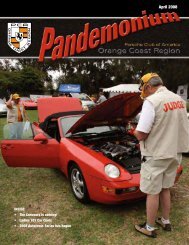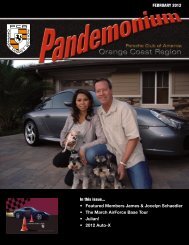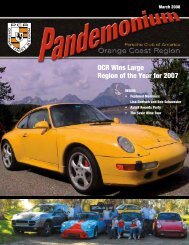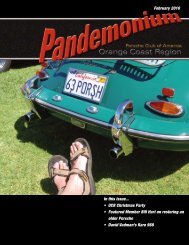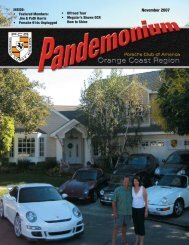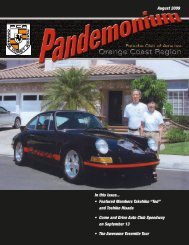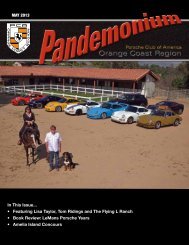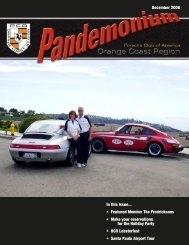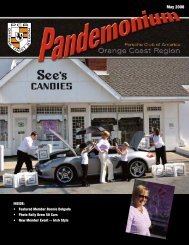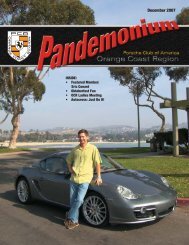September 2009 In this issue... • Featured Members Eric and Becky ...
September 2009 In this issue... • Featured Members Eric and Becky ...
September 2009 In this issue... • Featured Members Eric and Becky ...
Create successful ePaper yourself
Turn your PDF publications into a flip-book with our unique Google optimized e-Paper software.
“Let There Be Light”<br />
Story by Frank Cusenza PCAOCR member<br />
You already drive the best production<br />
sports car (Porsche) with terrific<br />
h<strong>and</strong>ling <strong>and</strong> braking. Just because the<br />
original owner didn’t opt for the Xenon<br />
package or the fact that your vehicle was<br />
manufactured before <strong>this</strong> option was<br />
available does not mean you have to miss<br />
out on <strong>this</strong> newer technology. Your daily<br />
driver no longer has to suffer with low<br />
visibility headlamps.<br />
First some basics: Halogen lights<br />
have a filament like a normal household<br />
bulb. Xenon bulbs do not contain<br />
filaments but are filled with gas much<br />
like a florescent tube. The color of the<br />
bulb depends on the gas mixture used in<br />
manufacture. Daylight has a temperature<br />
of 5,500 K (kelvin). Manufacturers<br />
assert that Xenon headlights will become<br />
the predominant type of headlight used<br />
in future cars. Not only are they three<br />
times brighter than traditional headlights,<br />
they provide better illumination for<br />
drivers, <strong>and</strong> the high intensity discharge<br />
system they employ is lighter <strong>and</strong> less<br />
expensive for car manufacturers to install<br />
in vehicles. Xenon headlights are also<br />
environmentally friendly. They typically<br />
last up to three times longer than halogen<br />
lights, while requiring half the current<br />
to function. My 2003 Boxster came<br />
equipped with H7 55-watt bulbs which<br />
give off 2,700 K temperature light. The<br />
conversion kit I chose gives off 6,000<br />
K light while providing three times the<br />
lumens output <strong>and</strong> uses only 35 watts of<br />
power. This is a much better solution<br />
than increasing the H7 bulb to 100 watts<br />
which only frosts the inner lens of the<br />
headlight module making it useless.<br />
A misconception exists regarding the<br />
ratings of Xenon bulbs that a 12,000 bulb<br />
is a stronger light source that a 3,000 bulb.<br />
Wrong. The rating is used to indicate the<br />
color of the light produced <strong>and</strong> lumens<br />
decrease as the numbers go up: 3K<br />
bulbs are yellow, 5K yellow/white, 6K<br />
white/blue, 8K blue, 10K blue/violet,<br />
12K violet. There are a couple of things<br />
to consider when making your choice.<br />
Daylight should be your first choice since<br />
<strong>this</strong> gives you the best night visibility <strong>and</strong><br />
makes the light emitted look natural. I<br />
chose 6K; however, 5K might be a best<br />
choice. Xenon kits come with 2 bulbs,<br />
2 ballasts, <strong>and</strong> 2 harness kits including<br />
rubber grommets for pass through into the<br />
lamp assembly.<br />
Let’s address the projector light<br />
provided as OEM equipment. The<br />
projector lens’ primary function is to<br />
project the beam of light to the driving<br />
surface. With factory-installed Xenon,<br />
during heavy braking the light beam<br />
would adjust up so as to maintain proper<br />
vertical height. This year the feature has<br />
been exp<strong>and</strong>ed to move to the side when<br />
turning. This is only available through<br />
factory installed Xenon; <strong>and</strong> although<br />
you could purchase the factory headlamp<br />
assemblies, you would not have the same<br />
functionality.<br />
I need to mention that factoryinstalled<br />
Xenon headlights are DOT<br />
approved but aftermarket Xenon kits are<br />
not DOT approved in California. We have<br />
all seen many Honda <strong>and</strong> Toyota cars on<br />
the road which enjoy the advantages of<br />
Xenon lamps. I checked the light pattern<br />
of my Halogen lights before I made the<br />
change by placing painter’s tape on the<br />
white cabinets on the back wall in my<br />
garage <strong>and</strong> having the car 20 feet away at<br />
the entrance. After making the installation<br />
I repeated the test using the Xenon lights<br />
with no headlamp adjustment <strong>and</strong> found<br />
the light patterns to be identical. Both<br />
bulbs have identical bases <strong>and</strong> thus are<br />
fully interchangeable. As a matter of<br />
fact, you can save the old Halogen bulbs<br />
to use as spares, put them back in the car<br />
when you sell it, <strong>and</strong> take your Xenon set<br />
to your new ride, if it does not come so<br />
equipped.<br />
Figure 1 Headlamp Assembly<br />
The reason I am writing <strong>this</strong> article is<br />
the fact that I was not able to find anyone<br />
to answer my questions on installing a<br />
HID (High <strong>In</strong>tensity Discharge Lamps)<br />
system in a Porsche. 1. Get one kit to<br />
replace the low beam lights. 2. Turn<br />
on your low beam lights <strong>and</strong> determine<br />
which bulbs you are replacing. No,<br />
Johnny...low beam does not mean that<br />
it is mounted lower than the high beam.<br />
<strong>In</strong> my Boxster the low beams are on top<br />
<strong>and</strong> the high beams are on the bottom. I<br />
had both assemblies in the car <strong>and</strong> had<br />
to redo them all. Save your time based<br />
on my experience. It’s not necessary to<br />
disconnect the battery. Just turn off the<br />
lights <strong>and</strong> do the work.<br />
Figure 2 Lamp Assembly Cover<br />
No wire cutting is required to install<br />
the harness; however, you will be required<br />
to drill a 1″ hole in the cover to allow the<br />
plugs to pass through. I used a 2x4 for<br />
support, predrilled a pilot hole <strong>and</strong> then<br />
used a 1″ wood bit to finish drilling the<br />
cover. I cleaned it all up with a Dremel<br />
tool to remove some support veins on the<br />
covers inside so that the grommet would<br />
fit snugly.<br />
Figure 3 Wired Lamp Assembl<br />
Do not touch the Xenon bulbs with<br />
your bare fingers. The oils from your<br />
skin will cause premature failure due<br />
to hot spots on the bulbs. Only h<strong>and</strong>le<br />
the base of the bulbs <strong>and</strong> be sure that the<br />
Continued on pg. 39)<br />
SEPTEMBER <strong>2009</strong> 29



